
28 Essential Jazz Blues Songs You Need to Know
Learning how to play over a jazz blues is essential for anyone looking to learn how to play jazz.
Though jazz blues is often one of the first jazz song forms students learn, it’s a vitally important one that will follow them throughout their respective jazz journey. The concepts you’ll learn through jazz blues songs will help you become a better jazz musician.
That’s why we’re about to explore what the blues is, the different types of blues often found in jazz music, and we’ll discover 28 essential jazz blues heads you should learn if you want to become the best player you can be!
If you want to take your jazz playing to the next level, check out the Learn Jazz Standards Inner Circle! The Inner Circle has everything you need to seriously improve your jazz chops.
Improve in 30 Days or Less. Join the Inner Circle.
Why Learn The Blues?
The jazz blues is an iconic and (relatively) easy jazz form that contains every essential ingredient for becoming the best jazz player you can be.
By learning many jazz blues songs, you’ll unlock the essential harmonies, melodic devices, rhythms, and all-around blues attitude to succeed in jazz.
The blues has played a central role in jazz music since the genre’s beginning. It is undoubtedly one of the most important forms of music, especially jazz music.
What is the Blues?
The Blues is a musical tradition that evolved out of the religious and work songs of enslaved African Americans in the 19th century. After emancipation, the blues spread throughout the American South, following Black communities and spreading nationwide.
By the 1920s, recording technology had developed enough to create recorded documents of the American musical landscape. By this time, the blues had seventy-plus years to evolve and spread. One of the blues’ progenies was jazz music.
What is Jazz Blues?
Let’s briefly identify the three basic elements of jazz:
- Syncopated Rhythms
- Swing Feel
- The Blues
You hear the blues in action when you listen to a jazz song. Specifically, you are hearing microtonalism at work. The blues tradition uses microtonal notes that fluctuate between the set pitches of standard Western music.
These microtonal notes are colloquially referred to as blue notes. They are an intimate part of jazz melodies and phrasing. Learning many blues songs is the best way to incorporate blue notes into your playing.
For more on the blues scale, check out our blues scale guide.
How Many Different Types or Genres of Jazz Blues Are There? (Different Blues Chord Progressions)
Every jazz musician needs to know several jazz blues heads that cover the range of all blues variations.
By their very nature, jazz musicians like to bend and break the rules that govern form and style. As a result, some jazz blues songs are barely recognizable as traditionally bluesy despite being rooted in some element of the blues, whether in form, harmonic devices, or simply in rhythm or “feel.”
- Some jazz blues tunes abandon 12 bars entirely, opting for longer forms.
- Others tweak or abandon completely the I-IV-V harmony of the traditional blues, opting for different chord progressions.
- Some jazz artists change the time signature, opting for a 3/4 or a 6/8 feel.
- Others change the rhythm or feel of the blues entirely, leaving behind traditional shuffle and swing rhythms and opting for straight 8ths, Latin feel, or other types of feel.
Before digging into our list, it’s essential to know a bit about the blues landscape in jazz music. Here are some of the most common jazz blues variations:
1. Traditional/Simple Blues Form
This is the foundational blues form, primarily using three chords: the I7, IV7, and V7.
Typical blues progression:

2. Standard Jazz Blues (Bebop Blues)
Add some jazz harmony to the traditional blues form, and you will get the jazz blues form! The standard jazz blues progression commonly incorporates II-V progressions and chord substitutions.
Typical jazz blues progression:
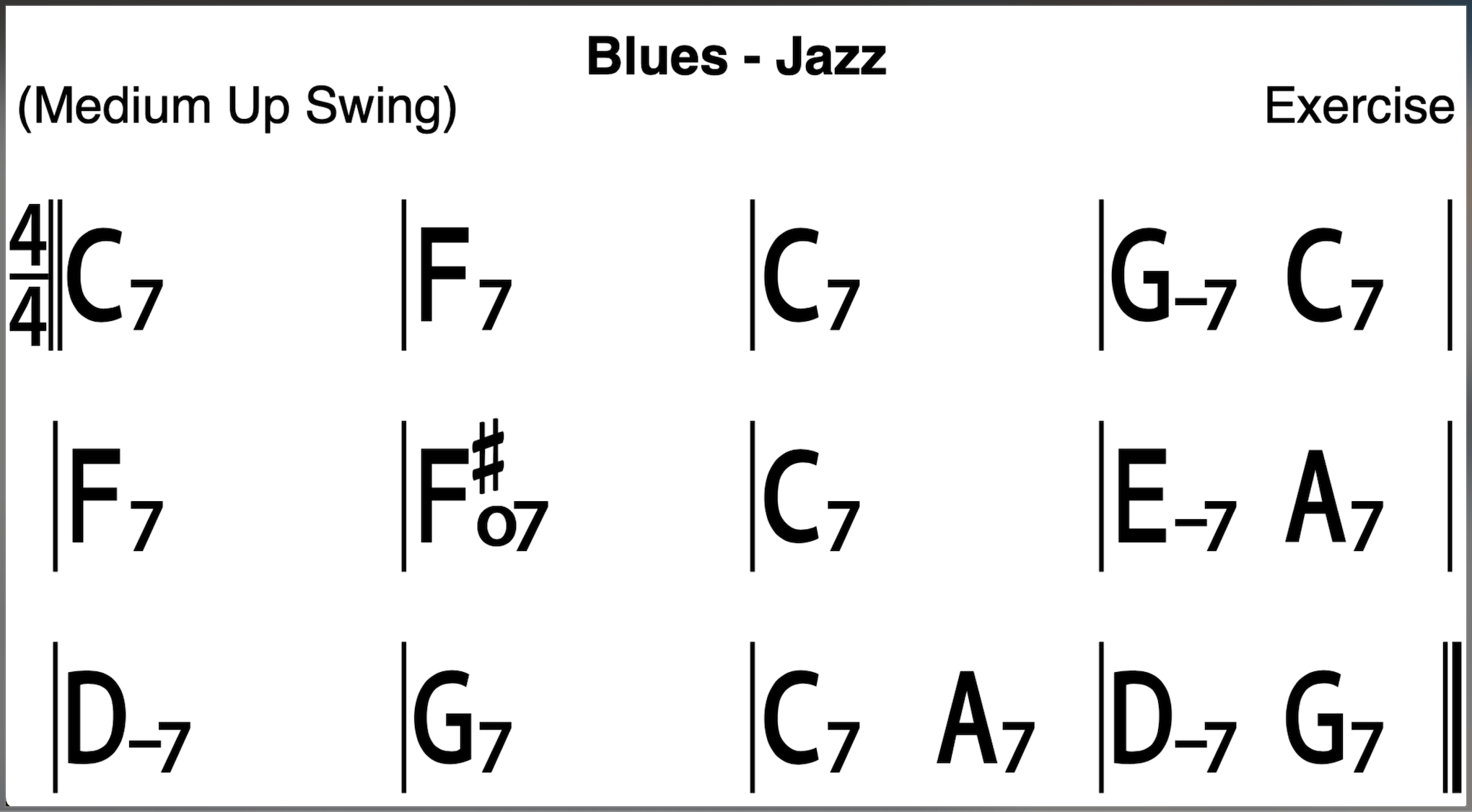
3. Minor Jazz Blues
The minor blues takes the regular blues progression and brings it into a minor tonality. Essentially, the chords used are often minor 7th chords instead of dominant 7th chords.
Typical minor jazz blues progression:
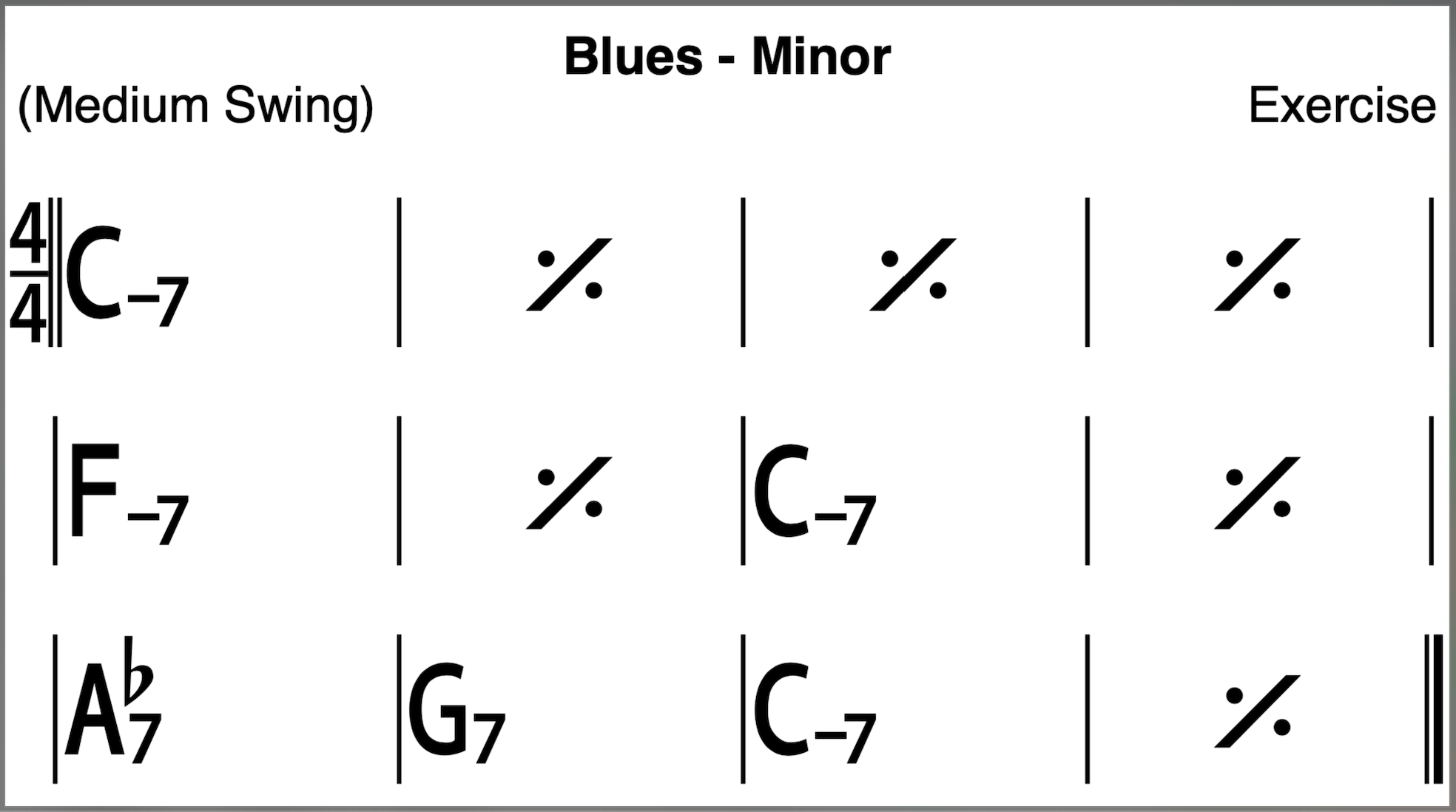
4. Blues Waltz (Blues in 6/8 or 3/4 Time)
The blues is traditionally in 4/4 time, but jazz musicians like to break the rules! Some jazz musicians play the blues in 3/4 or 6/8 time.
Typical 3/4 jazz blues progression:
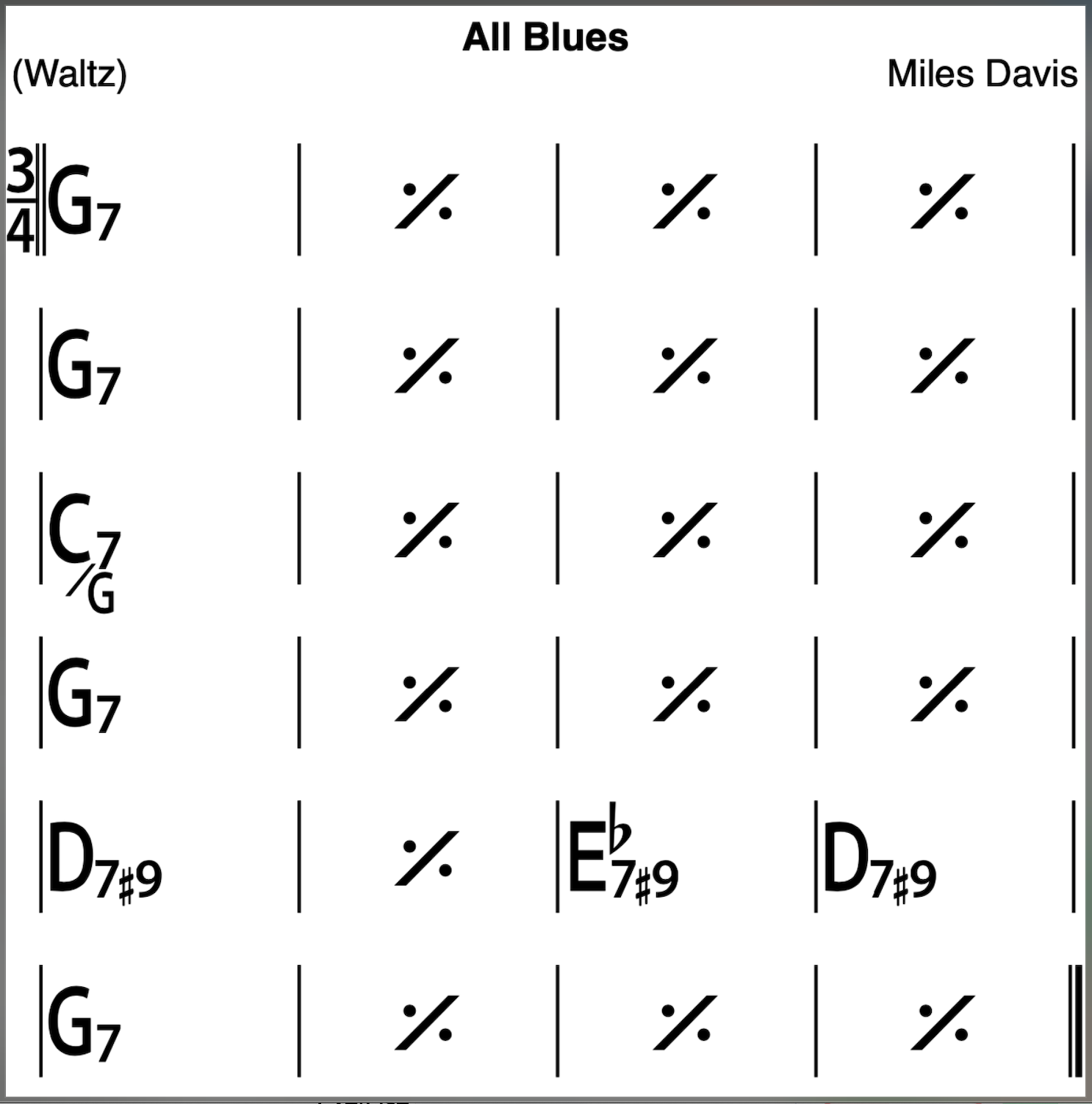
5. “Bird” Blues:
Named after Charlie “Bird” Parker, this jazz blues form modifies the traditional blues progression with a series of II-V substitutions, creating a harmonically rich environment for bebop musicians to play over.
While retaining a 12-bar structure, the harmonic progression differs significantly from the traditional blues.
Typical “Bird” Blues Progression:
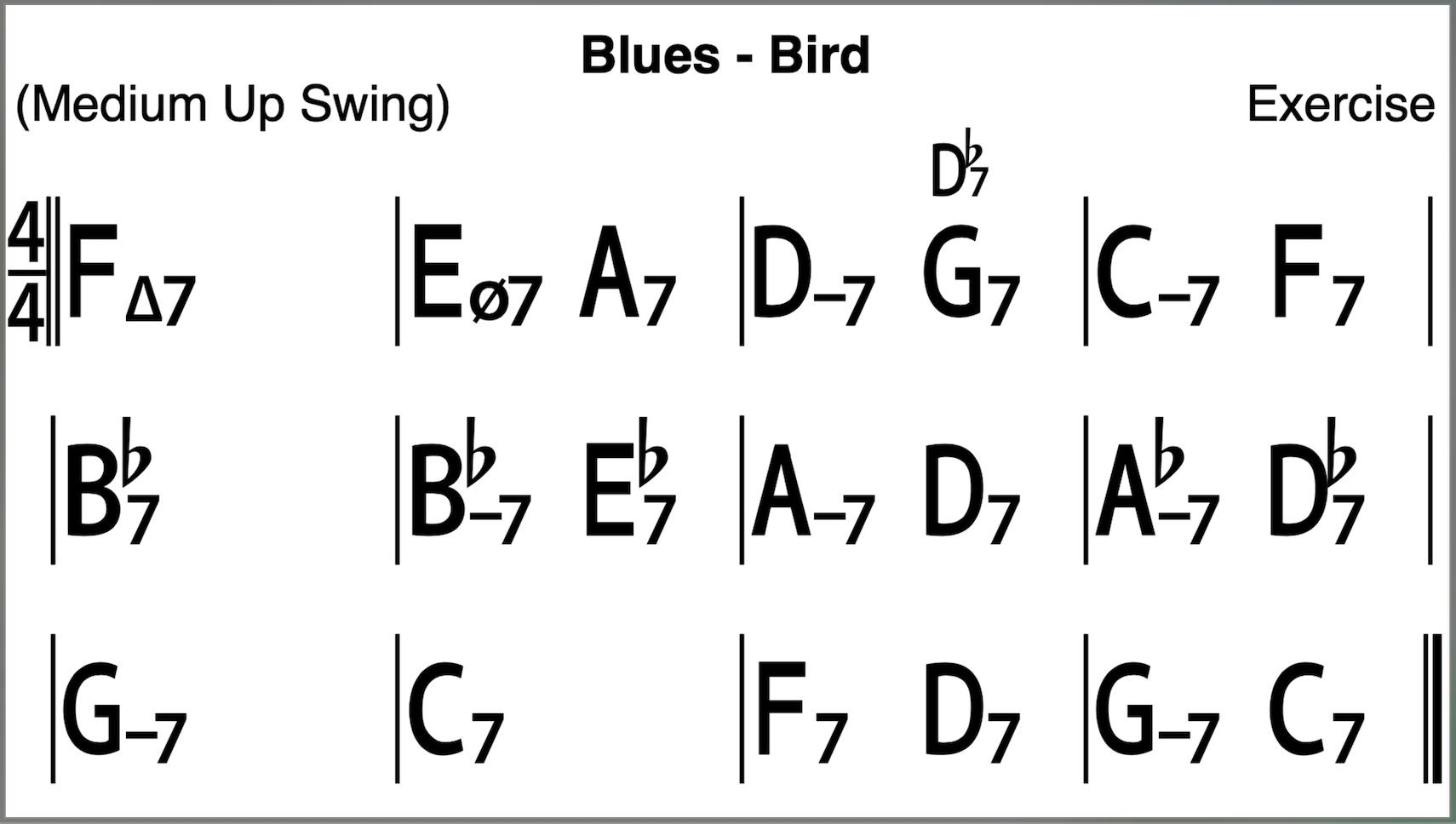
6. Extended Blues Forms
Some blues tunes don’t stick to the standard 12-bar format and may extend to 16 bars, 24 bars, or even longer. These extended forms might repeat certain sections of the standard blues progression or introduce new sections.
Example Extended Jazz Blues Progression:
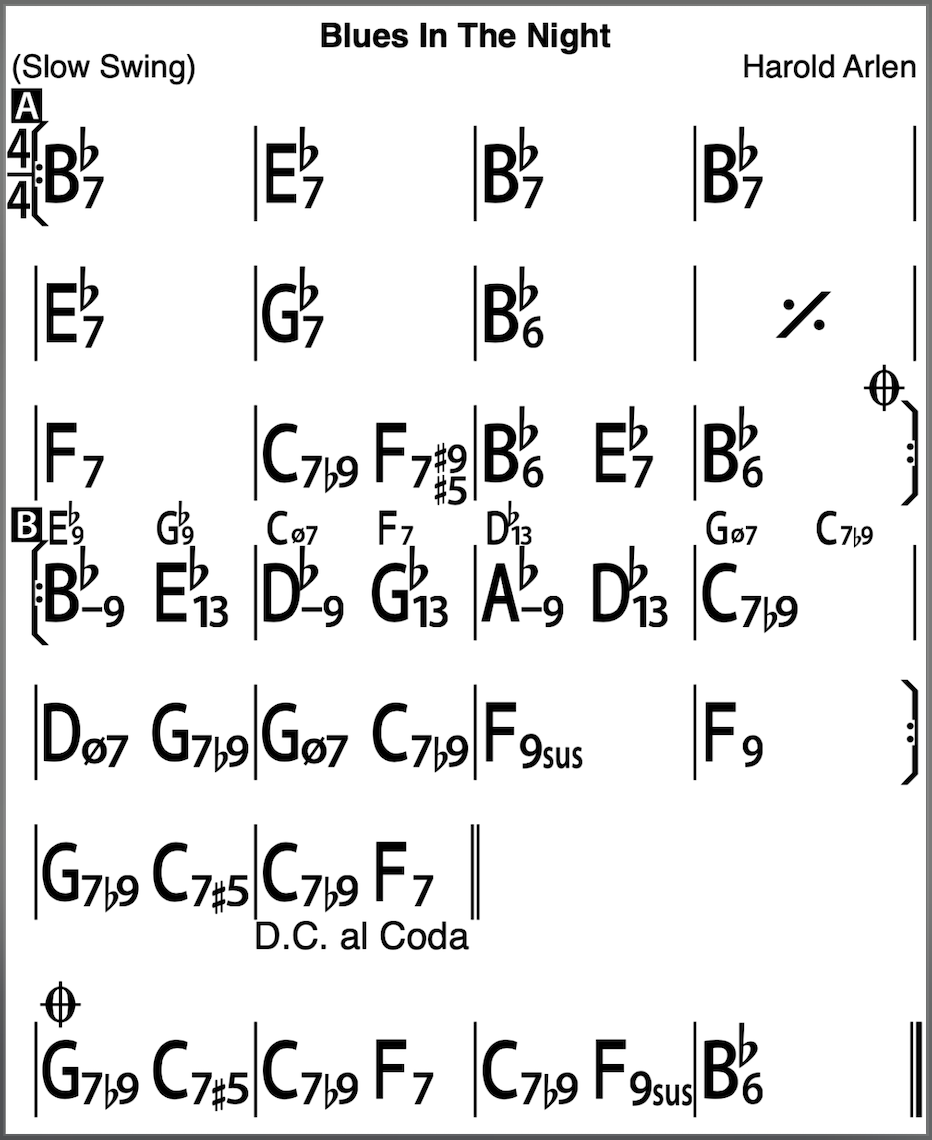
For more on blues chord progressions, check out 4 Blues Chord Progressions To Help You Master The Blues.
Also, check out this video to dive deeper into different jazz blues forms:
28 Jazz Blues Tunes You Need to Know
The following blues heads are must-knows for jazz musicians, and there are a few reasons why you should learn all of these blues tunes at some point:
- Many of these songs are jam session staples, and knowing them might prevent some awkward bandstand interactions!
- The melodies of these songs are dripping with incredible jazz language, which you can internalize and incorporate into your own playing.
- Despite all the variations in these blue forms, they are generally great vehicles for practicing jazz improvisation, providing you with a clear and easy-to-navigate runway for practicing your jazz solo ideas.
Many different blues heads have become popular among jazz musicians, but this is a great list to help you get started!
Be sure to click through on the links under each entry to play along with these jazz songs.
1. All Blues

image source: Wikipedia
All Blues is a jazz blues in 3/4 time with a unique turnaround at the end. It first appeared on the Miles Davis album Kind of Blue.
Composer: Miles Davis
Play along with All Blues here.
2. Au Privave
Au Privave is a staple bebop blues with an iconic blues melody.
Composed by Charlie Parker
Play along with Au Privave here.
3. Bag’s Groove
This is a classic blues song with many great recorded versions. Definitely check out the Miles Davis album Bag’s Groove featuring Milt Jackson.
Composed by Milt Jackson
Play along with Bag’s Groove here.
4. Billie’s Bounce
image source: Wikipedia
Billie’s Bounce has many iconic recorded versions, with renditions from great jazz artists like jazz guitarist George Benson and jazz pianists Keith Jarret and Bud Powell.
Composer: Charlie Parker
Play along with Billie’s Bounce here and check out our article on the best jazz saxophonists for more on players like Charlie Parker.
5. Birk’s Works
This minor blues composition has some interesting chord variations that add more harmonic complexity to the form. Despite the harmony being slightly more complicated than a standard minor blues, the melody is simple and iconic.
Composed by Dizzy Gillespie
Play along with Birk’s Works here.
6. Blue Monk
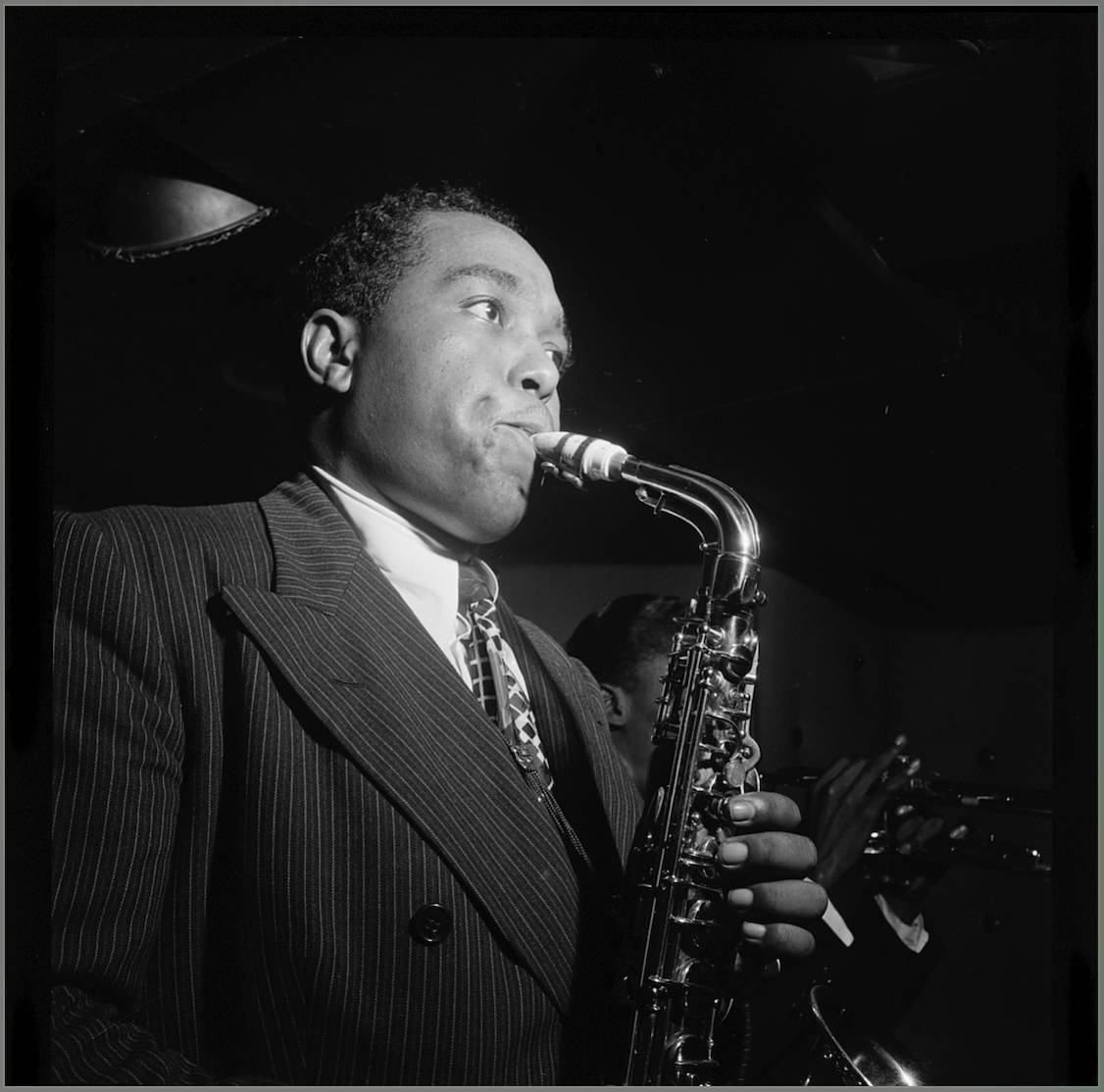
image source: Wikipedia
This is the composition that Thelonius Monk recorded the most and is a quintessential jazz standard. This list has many incredible melodies, but Blue Monk might be the most infectious. The opening theme inspired the beginning of the melody for the Disney song Cruella De Vil.
Composer: Thelonius Monk
Play along with Blue Monk here.
7. Blues For Alice
This is the first “bird” blues on our list. The harmonies are different than a standard blues, but the feel, phrasing, and attitude scream blues.
Composer: Charlie Parker
Play along with Blues for Alice here.
8. Blues In The Closet
Jazz bassist Oscar Pettiford wrote this tune, and it has become a jam session staple.
Composed by Oscar Pettiford
Play along with Blues In The Closet here.
9. C-Jam Blues
image source: Wikipedia
I bet you know this tune even if you have never heard it before. This blues head is one of the easiest blues heads you can learn—you only have to play two notes!
Composer: Duke Ellington
Play along with C-Jam Blues here and discover more great jazz pianists like Duke Ellington by checking out our article on the best jazz pianists.
10. Cheryl
Charlie Parker recorded “Cheryl” several times, though a well-known recording was made in 1947 with a lineup that included Miles Davis on trumpet, Duke Jordan on piano, Tommy Potter on bass, and Max Roach on drums. Definitely check that one out!
Composer: Charlie Parker
Play along with Cheryl here.
11. Chi Chi
Learning Charlie Parker blues heads will infuse your playing with so much great vocabulary. Chi Chi is another great Parker head you should know.
Composer: Charlie Parker
Play along with Chi Chi here.
12. Cool Blues
I bet you are noticing many Charlie Parker tunes on this list. If you didn’t understand how influential he was before this article, hopefully, you’ll see his influence now! Cool Blues is another simple blues head you ought to know.
Composer: Charlie Parker
Play along with Cool Blues here.
13. Equinox

image source: Wikipedia
This is a slow minor blues tune by John Coltrane. Its slow tempo allows the players to stretch out over the music and develop their solos.
Composed by John Coltrane
Play along with Equinox here.
14. Freddie Freeloader
This is another blue from the classic jazz Miles Davis album Kind of Blue. Wynton Kelly’s piano solo is full of incredible jazz blues language.
Composer: Miles Davis
Play along with Freddie Freeloader here.
15. Footprints
image source: Wikipedia
Footprints is a slow blues in 3/4 written by Wayne Shorter. It features a unique turnaround and an iconic bass line.
Composer: Wayne Shorter
Play along with Footprints here.
16. Freight Trane
Freight Trane is another great example of a “bird” blues. Check out Kenny Burrell and John Coltrane’s version of the song on the album aptly named Kenny Burrell and John Coltrane.
Composer: Tommy Flanagan
Play along with Freight Trane here.
17. Mr. P.C.
This is a classic minor blues by John Coltrane. The original version features a dizzying solo by Coltrane.
Composer: John Coltrane
Play along with Mr. P.C. here.
18. Now’s The Time
Unlike his other jazz blues tunes, Now’s the Time features a melody that is fairly simple and repetitive. This is one of Parker’s easier blues heads.
Composer: Charlie Parker
Play along with Now’s The Time here.
19. Relaxin’ At Camarillo
If you learn the head of Charlie Parker’s Relaxin’ at Camarillo, you’ll have plenty of incredible material to use for jazz solos. This is another iconic blues you should know.
Composer: Charlie Parker
Play along with Relaxin’ At Camarillo here.
20. Route 66
This is a classic jazz standard that has seen cross-genre appeal, with many artists from rock and pop creating their own versions of this classic song.
Composer: Bobby Troup
Play along with Route 66 here.
21. Sandu
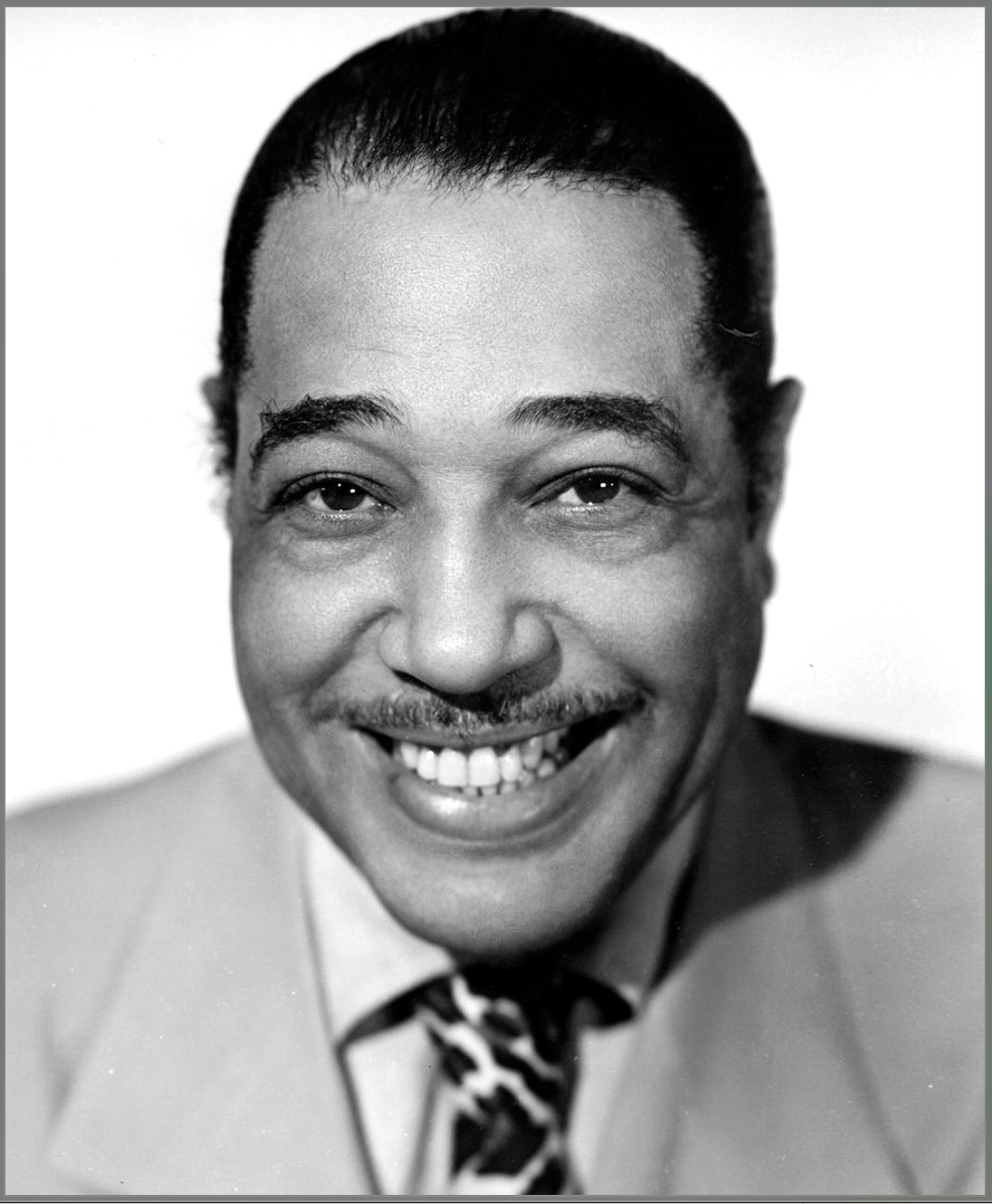
Sandu has an iconic and catchy jazz blues melody. This is definitely a jam session standard.
Composer: Clifford Brown
Play along with Sandu here.
22. Sonnymoon For Two
Sonnymoon For Two is a great medium-tempo blues head you ought to learn. Sonny’s solo is an incredible example of how to develop a theme when playing a solo.
Composer: Sonny Rollins
Play along with Sonnymoon For Two here.
23. Straight No Chaser
Another great Thelonius Monk composition! This blues is another iconic jam session jazz standard.
Composer: Thelonius Monk
Play along with Straight No Chaser here.
24. Take The Coltrane
Duke Ellington wrote this classic blues song for John Coltrane.
Composer: Duke Ellington
Play along with Take The Coltrane here.
25. Tenor Madness
image source: Wikipedia
This Sonny Rollins composition is the only known recording featuring Sonny and John Coltrane.
Play along with Tenor Madness here.
26. Things Ain’t What They Used To Be
Another Duke Ellington blues, Things Ain’t What They Used To Be is a classic, beginner-friendly blues tune.
Composer: Duke Ellington
Play along with Things Ain’t Ain’t What They Used To Be here.
27. Watermelon Man
This is a 16-bar blues by Herbie Hancock that has an extra four-bar system added to it. In this system, the harmony goes back and forth between the V7 and the IV chord.
Composed by Herbie Hancock
Play along with Watermelon Man here.
28. West Coast Blues
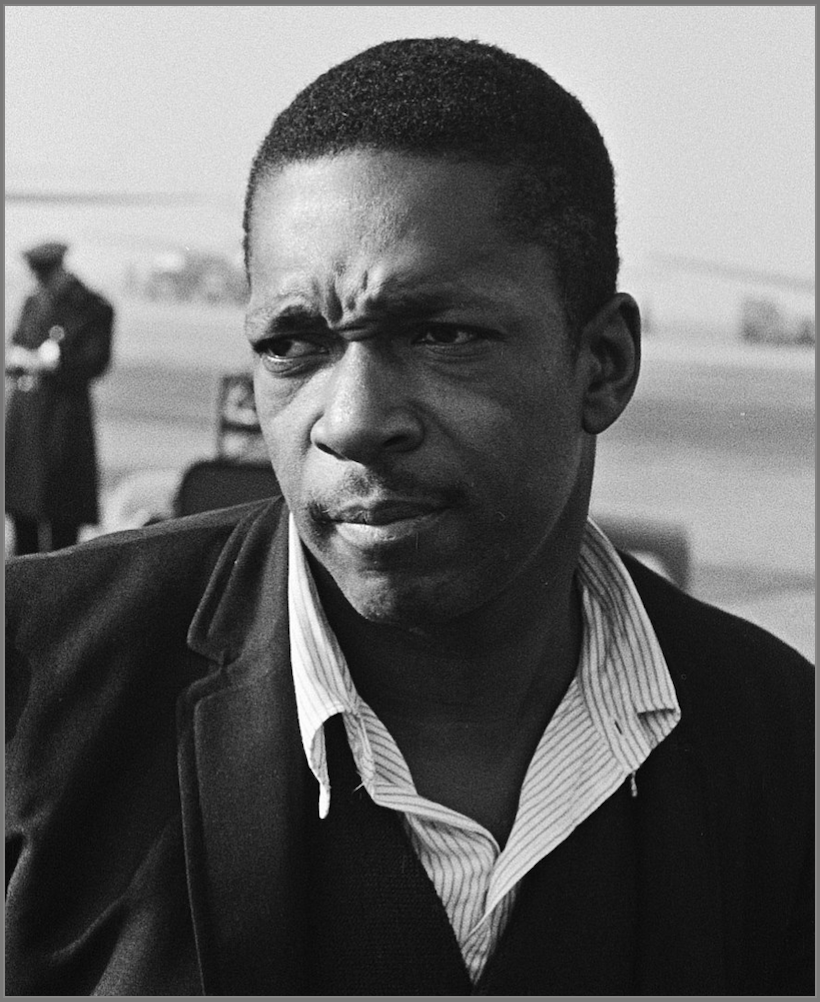
image source: Wikipedia
West Coast Blues is a blues waltz by Wes Montgomery and is an awesome example of the music that came out of the cool jazz era. It’s definitely a must-know (especially for guitarists).
Composer: Wes Montgomery
Play along with West Coast Blues here, and check out our article on the best jazz guitarists to discover other guitarists like Wes Montgomery.
What’s Next?
These 28 blues heads contain all the essential ingredients you need to learn the jazz language. Try playing a new one every week. After six months or so, you’ll know all 28!
Something simple you can do to start playing great jazz blues solos right away is to repurpose themes from blues heads and apply them to different parts of the song or to other songs. This is a sure way to improve your jazz solos and get comfortable with playing these ideas in different keys and styles.
Check out this video for more on how to take vocabulary and move it around in different musical contexts:
If you want to learn more about the elements of jazz language, check out this article on jazz licks.
Dive Headfirst Into The Blues. Join The Learn Jazz Standards Inner Circle
Want a comprehensive and structured approach to learning jazz music?
The Inner Circle helps you grow into the best jazz musician you can be. Whether you play guitar, piano, trumpet, saxophone—or anything—the Inner Circle has abundant resources and instrument-specific courses designed to help you master your instrument and play what you hear.
We also have Jazz Blues Accelerator and Minor Blues Accelerator courses to help you master the blues.
Improve in 30 Days or Less. Join the Inner Circle.
Link nội dung: https://vosc.edu.vn/blues-jazz-a69025.html